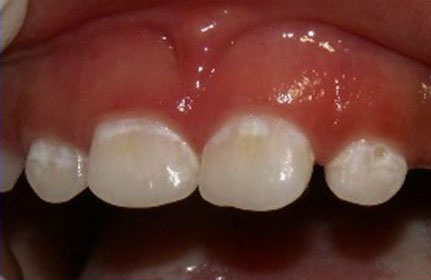Children pass through developmental milestones. You couldn’t ask a one year old to tie their own shoes the same way you couldn’t ask a one week old to walk. Children continue to build on their physical abilities by learning balance, to understand “proprioception” (their limbs in space) and hand-eye coordination. Just like tying shoes, walking, coloring in the lines and riding a bike, children must learn to brush their teeth. Studies have found that children’s manual dexterity is not developed enough brush their own teeth properly until 7-8 years of age.
But, unlike coloring in the lines, there are serious consequences for failing to appropriately brush teeth. Research shows that when unsupervised, children under age seven tend to brush in a more haphazard pattern and for shorter duration than those assisted by an adult. As a result, without help, a child will often miss areas of a tooth, or even whole areas of the mouth. Over time, cavities begin to form.
Take a look at this photo:

Photo Credit: Joanna Douglass BDS DDS
The white lines seen here along the border of the tooth and gums are commonly seen as the start of early cavities forming from plaque sitting on the teeth. We regularly encourage all children and parents to brush in small circles with the brush bristles angled toward the gums – to avoid exactly these kinds of early cavities! Not only that, but pain from cavities can lead to adverse effects on learning, communication, and even nutritional deficiencies.
The good news? Studies have shown that children who are assisted in brushing two times a day are less likely to end up with cavities. When an adult helps a child brush they assure that all surfaces of all teeth are cleaned for the recommended full two minutes. What do you do if your child hates brushing? We recommend fluoridated children’s toothpaste in fun flavors: strawberry, mango or even chocolate. Many children’s pastes don’t foam the way adult’s do and kids tolerate them better. To encourage your child, try songs, videos, brushing as a family, sticker charts, or anything else that might get your child excited.
Brushing with kids requires creativity, persistence, patience… and definitely lots of practice. While the motion of brushing may seem simple, we bet so does coloring inside the lines of a kid’s coloring book!
